7.1. Concepts: Force of Friction and Normal Force; Free Body Diagrams
Introduction
Friction is a common force in nature. It is a force that is created whenever two surfaces in contact move or try to move across each other. Friction is also a contact force (it appears when there is contact between two surfaces).
When we apply a pushing or pulling force on an object sitting on the floor, a force of friction will appear; the direction of this force will oppose the tendency of the object's motion.
Concepts
There are two possible outcomes:
- The force is not big enough to overcome friction—the object will not move. Friction will be called static friction.
- The force is big enough to overcome friction—the object will start moving. Friction will be called kinetic friction.
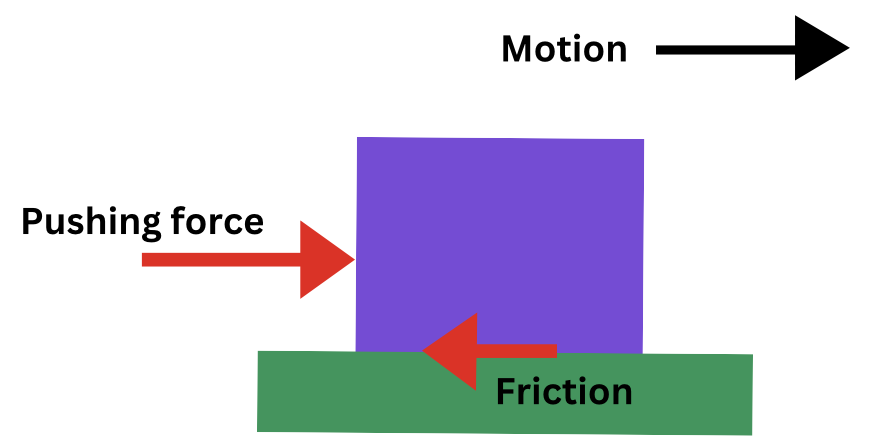
The force of friction has the following properties:
- Friction is a contact force.
- Friction always opposes the motion of the object.
- Friction is dependent on the type and smoothness of the material of both surfaces in contact.
- Friction is dependent on the amount of contact force pushing the two surfaces together (called normal force).
The type and smoothness of the surfaces are described by the coefficient of friction. The coefficient of friction is defined as the ratio between the force of friction and the normal force:
Since it is the ratio between two forces, coefficient of friction is unitless. Refer to Appendix 1 for values of coefficient of friction.
Coefficient of Static Friction
Static friction occurs when two surfaces try to move past each other. It can be thought of as the friction that prevents an object from sliding on a surface. For instance, a person pushing a box on the floor when the box is not moving, is an example of static friction.
Using the coefficient of static friction, the force of friction can be calculated as:
Coefficient of Kinetic Friction
Kinetic friction occurs when two surfaces move past each other. It can be thought as the force that makes it harder for an object to slide on a surface. For instance, a crate moving while pulled on a level floor is an example of kinetic friction.
Using the coefficient of kinetic friction, the force of friction can be calculated as:
Analyzing the motion with friction
Example 1: Horizontal contact surface
Assume a brick is being pulled with a force F across a horizontal floor. A force of friction will develop acting in the opposite direction of the motion.
The first step in analyzing the motion is to create a free body diagram (FBD) appropriate for the situation.
A free body diagram is a graphical representation of the object and of all external forces acting on it.
To create a free body diagram and to analyze the motion of the object, follow these steps:
- Remove the object from its surroundings.
- Assign a frame of reference (x and y axes).
- Draw all external forces acting on the object.
- Resolve forces on the x and y axis.
An example of a FBD is represented below; in this situation, a box is being pulled on the floor by a force F that makes an angle θ with the horizontal.
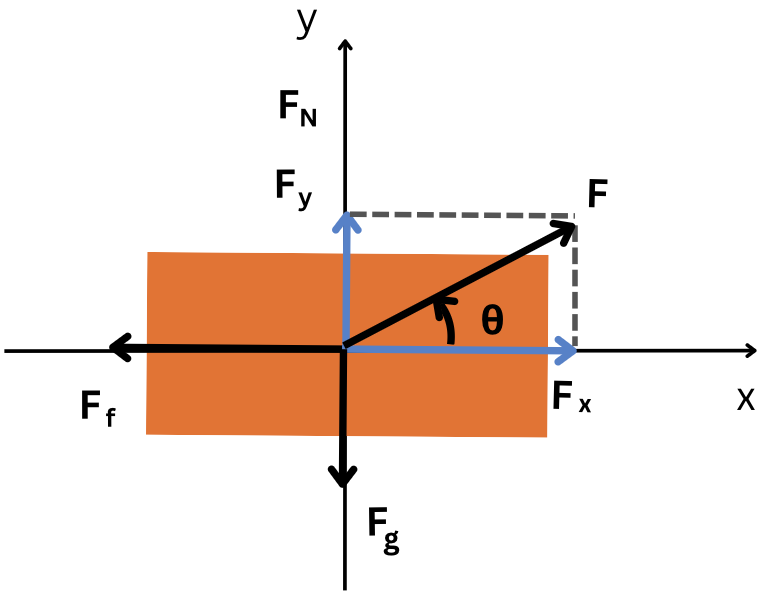
In Figure 7.2:
[latex]F[/latex] – represents the pulling force. The force is not on the x or y axis, so it needs to be resolved on the axes (components, [latex]F_x[/latex] and [latex]F_y[/latex], need to be drawn on the FBD and calculated)
[latex]F_f[/latex] – represents the force of friction (opposite to the motion)
[latex]F_g[/latex] – represents the force of gravity (always directed towards the ground)
[latex]F_N[/latex] – normal force (the reaction to the force of gravity). The normal force is always perpendicular to the contact surface.
Example 2: Vertical contact surface
An object is being pushed against a vertical wall (Figure 7.3).
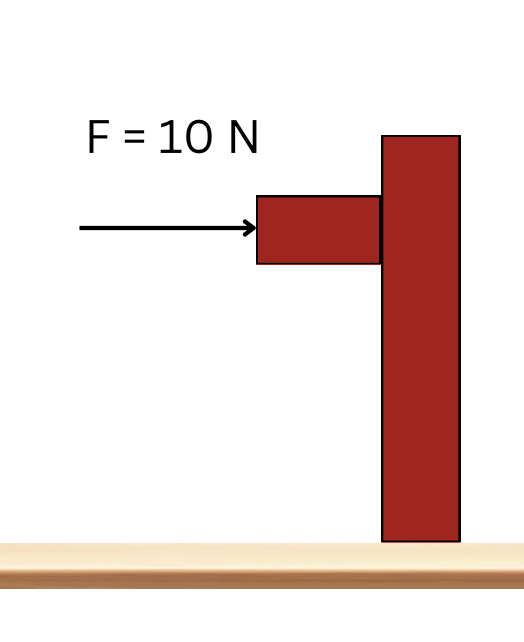
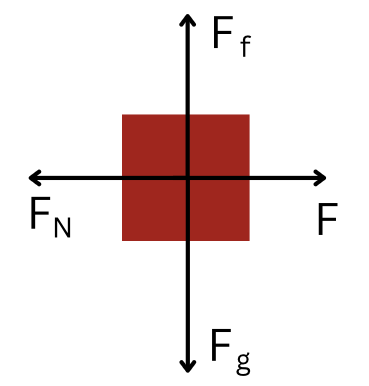
In Figure 7.3:
[latex]F = 10 \text{ N}[/latex] – represents the pushing force.
[latex]F_f[/latex] – represents the force of friction (opposite to the motion). The object has a normal tendency to slide down; force of friction will oppose this tendency of motion, therefore being directed upwards.
[latex]F_g[/latex] – represents the force of gravity (always directed towards the ground).
[latex]F_N[/latex] – normal force (the reaction to the pushing force). The person pushes with a force F on the wall; the wall reacts with a force equal in magnitude and opposite in direction – normal force. The normal force is always perpendicular to the contact surface.
Example 3: Inclined contact surface
A brick sits on an inclined plane that makes an angle [latex]\theta[/latex] with the horizontal.
The FBD to analyze the motion in this case is:
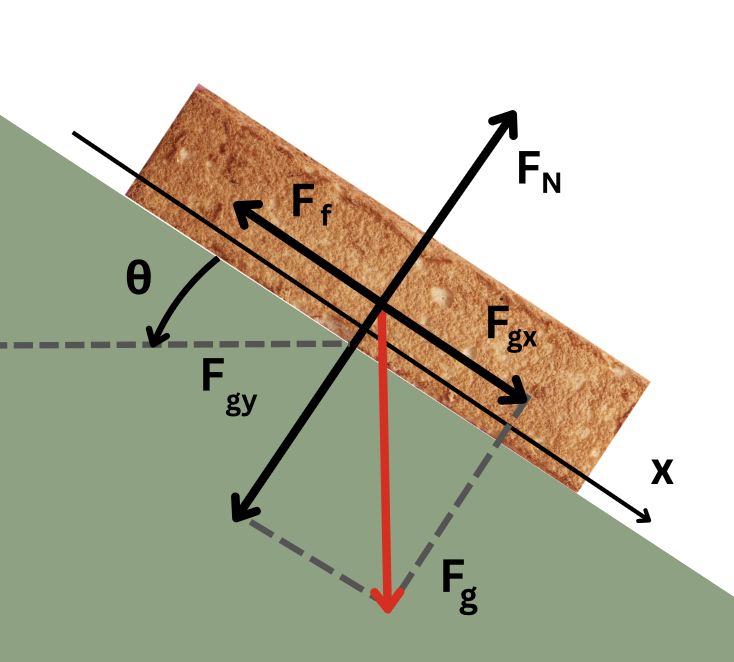
In Figure 7.4:
[latex]F_g[/latex] – represents the force due to gravity (resolved on the x and y axes to [latex]F_{gx}[/latex] and [latex]F_{gy}[/latex])
[latex]F_f[/latex] – represents the force of friction (opposes the natural tendency of the object to slide down the incline due to the x component of gravity)
[latex]F_N[/latex] – represents normal force (always perpendicular to the contact surface – here the ramp)
Image Attributions
- Figure 7.1: Created with Canva and licensed under CC-BY-NC-SA 3.0
- Figure 7.2 - 7.3: Created with Geogebra and licensed under CC-BY-NC-SA 3.0
- Figure 7.4 adapted from:
- Bread Toast by wayhomestudio courtesy of Freepik

